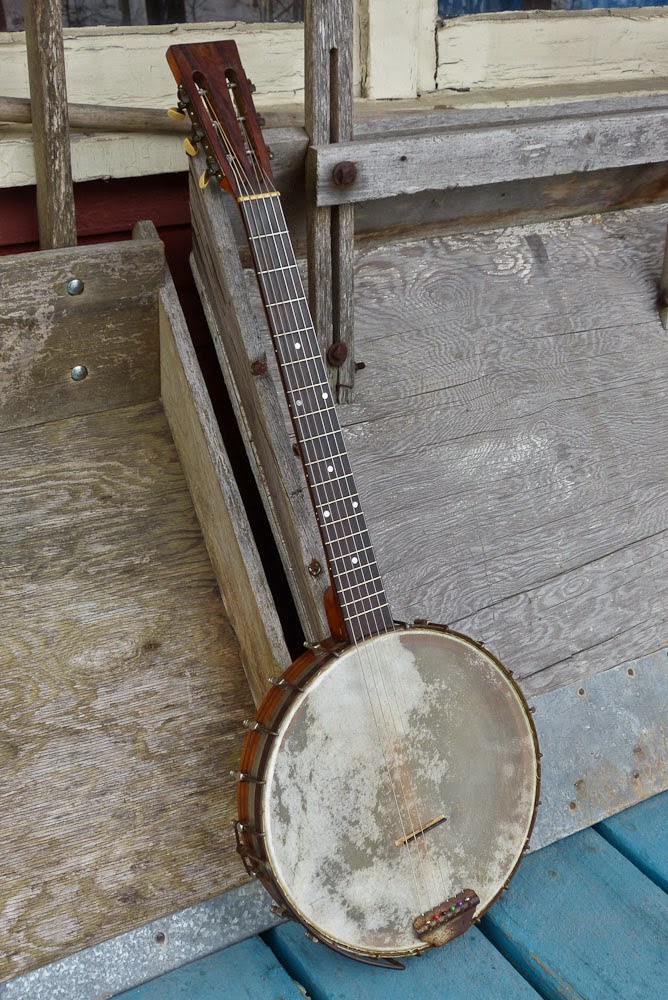1920s Oscar Schmidt Sovereign-style Banjo-Guitar
I've updated this post with new text, pictures, and a new soundclip as well because I've done some adjusting to the instrument since I posted it last.
This is a 1920s Oscar Schmidt (Jersey City, NJ) 6-string banjo-guitar and when it was made it probably would've found its way into the hands of early jazz or blues players. There were a number of strong 6-string banjo players in early jazz bands because, if you played guitar and not tenor banjo, these instruments gave you the power to cut and fit into the mix (ie, chord comping) like a tenor banjo would. For blues, ragtime, or folkie players this sort of instrument will give you a fantastic, punchy fingerpicking tone with volume to spare. It also... sounds like a banjo!
Years ago I sold this very instrument to a friend who recently traded it back to me (I'd since sold him a modern Deering 6-string banjo... more to his taste but really heavy) and after it came back I did some work which included: new skin head, new bridge, swap-out of the neck brace to a hanger-bolt/Gibson style neck attachment, fret level/dress, cleaning, and whatnot. It's since had its tires kicked by a few prospective buyers and was on loan for a few gigs but now it's back in the fold and I've "done it up" a little bit more, including re-using the original tailpiece (by modding it so it'd work better) and fitting a 2nd, lighter-weight bridge for a more traditional bright banjo sound. I also strung it up with regular electric-guitar 10s (47w-10 with a plain G) and compensated said new bridge for that.
The result? It's found its voice at last! This thing struts it right out there with plenty of pop, sizzle, and volume but also a nice, old-timey tone. The light gauges of the electric 10s put it firmly in a "banjo tesnion" comfort zone, too, which the head really enjoys.
This has a big 12 5/8" rim which is why I re-headed it with a new skin head (there aren't any regularly-available synthetics in this size).
The nut width is 1 3/4" with a flat-profile fretboard, narrow-ish vintage fret stock, and a medium C shape to the back of the neck. It's perfect for fingerpicking.
I added side dots but there were pearl dots in the board already. The neck is straight and action is spot-on at 3/32" bass and 1/16" treble at the 12th fret. This has a 25" scale length which is common to many Oscar Schmidt guitar products.
There's a black shim to knock the neck-angle back at the neck-join. A lot of old OS banjo rims distort over time (they're thinner than many other makes) which bells the bottom edge out slightly. So, in turn, when setting them up these days they almost always need a decent shim to push the neck angle back.
Fortunately, with the new hanger-bolt-style neck brace, the instrument is pretty stable.
I used a wider Grover 2-foot bridge and compensated it for these electric guitar 10s strings. The tailpiece is the original unit but I cut it a little bit so it'd be more snug and strung the strings "backwards" through the mounting holes so that the lip of the tailpiece would add some extra back-pressure on the bridge (and thus liven-up the tone and keep the bride more stable).
All the wood is maple on this instrument, with a dyed center-strip to the two-piece neck and dyed-maple rim-cap and fretboard.
It's pretty hard to beat the slotted-head look.
The original heel cap is missing but I did polish the heel's bottom up and put a bit of finish on it. Note my new hanger-bolt neck brace: it adjusts with one big hex nut to keep the thing stable. This is so, so, so much more practical and effective compared to the usual OS-style shim-type neck brace (which always comes loose and messes with setup). I wouldn't have installed it except that I felt it's needed on this instrument.
I forgot to mention that all the hardware and parts are 100% original save the bridge and new head.
I used the D'Addario EXL110BT ("balanced tension") set of strings.
This banjo also comes with a nice clip-on-the-hooks brown strap, 2nd heavier rosewood (also compensated) bridge to pull out some "darker" tones, a beat-up old chip case, and... best of all... a hex wrench of the right size to tighten or loosen-up the head (which is a seasonal thing, considering the skin head).


















Comments